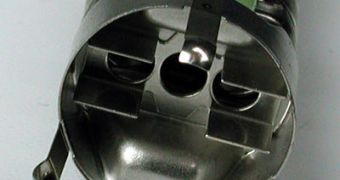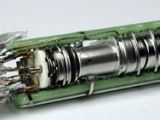Electron guns are devices often used by CRT "cathode ray tube" displays in order to produce light on a phosphorus-coated glass screen. This is how CRTs work. The electron gun generates a beam of electrons which is targeted at the screen. The beam can be deflected on all three axes by the image driver with the help of either a magnetic or an electric field, thus creating an image pattern on the screen. Electrons are being absorbed into the phosphorus layer, exciting it in order to emit photon particles of light.
Construction and operation
The role of electron guns is solely to generate and to accelerate the electron beam inside the CRT tube. They do this by heating a small cathode element, which generates a cloud of electrons through thermionic emission. The electrons then pass through a Wehnelt cylinder, which makes use of an electric field to focus the beam of electrons. Once this is done, the electrons are being accelerated with the help of one or two anode electrodes carrying a large voltage in relation to the cathode electron emitter.
Between the anode and the cathode, a repulsive ring is placed so that the electrons are further focused onto a small spot on the anode, to lower the energy required to extract the electrons from the surface of the cathode. The anode spot is generally a hole, to allow the electrons to form a collimated beam that will later reach the collector, which has the role of gathering the electrons emitted from the electron gun.
Similar applications
The whole system, including the electron gun and the collector, can be used for a so called Einzel lens. The principle of the electron gun basically applies to all ion guns, but mostly to those firing electrons. This particular ion gun consists of a cylinder inside which gas is being pumped. Electrons are being fired from the inner walls of the cylinder to ionize the gun, while an extraction electrode is used as anode to concentrate the beam of ions.
The vast majority of color television sets use three electron guns, one for every basic color of the visible electromagnetic spectrum, red, green and blue. All three electron beams travel on separate paths and are targeted at each of the three phosphor layers to produce light, and finally a pixel, which is a combination between the three basic colors.
There are various types of electron guns, classified accordingly to the type of electric field generation, mechanism of electron emission, focusing mechanism and number of electrodes. Aside from being on of the most important component in CRTs, electron guns can also be used to ionize particles, in technologies such as mass spectrometers via electron ionization.

 14 DAY TRIAL //
14 DAY TRIAL // 
